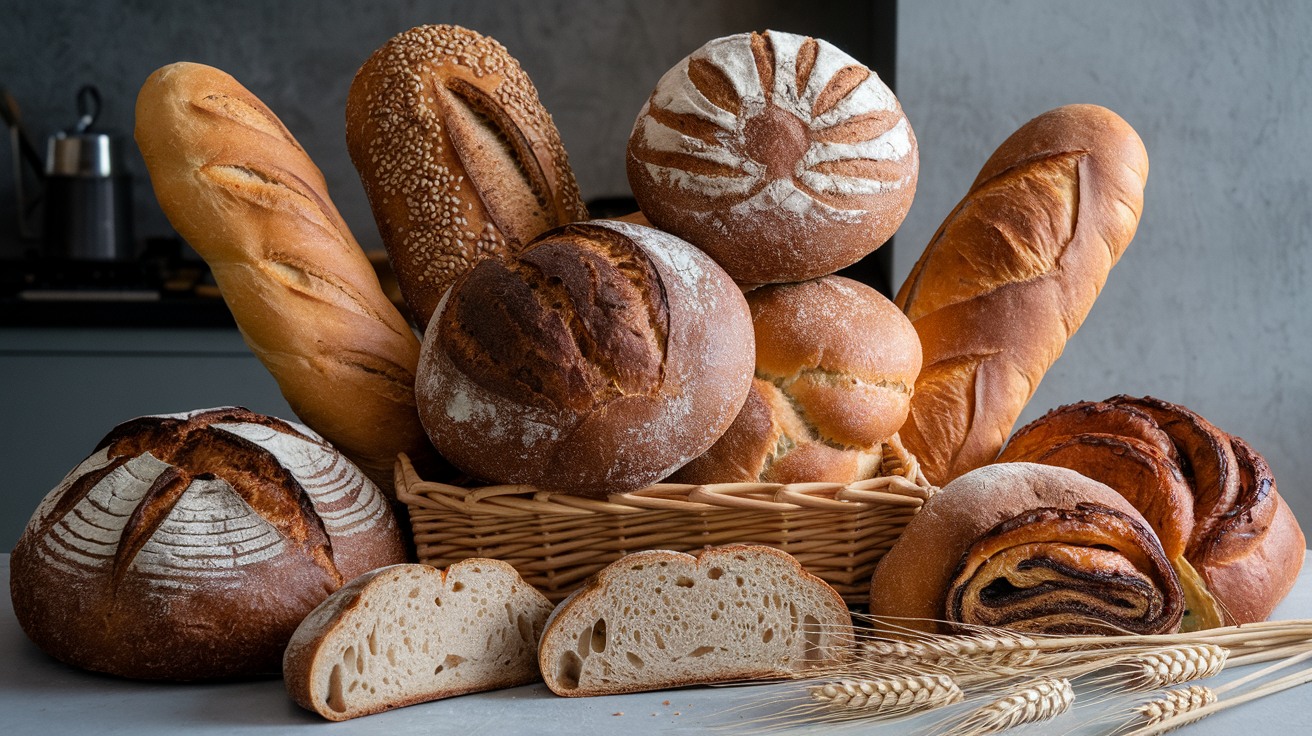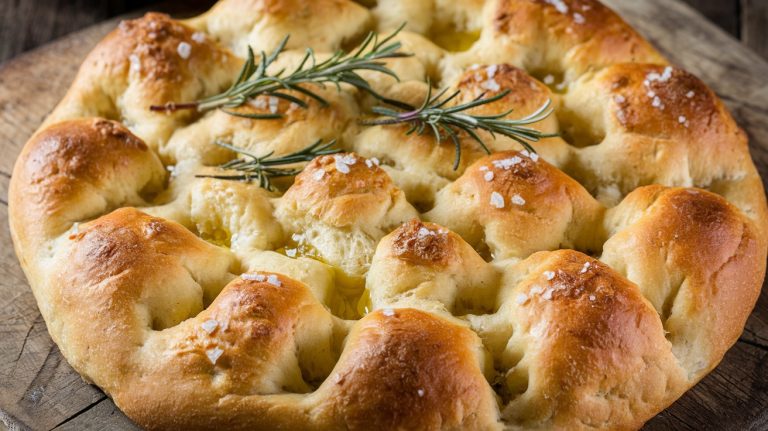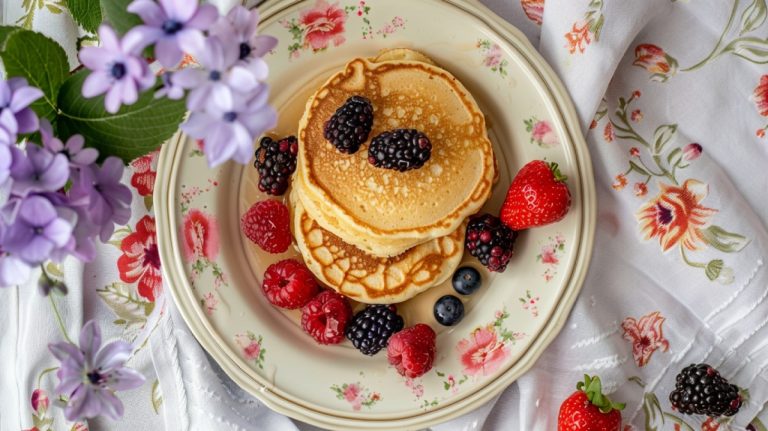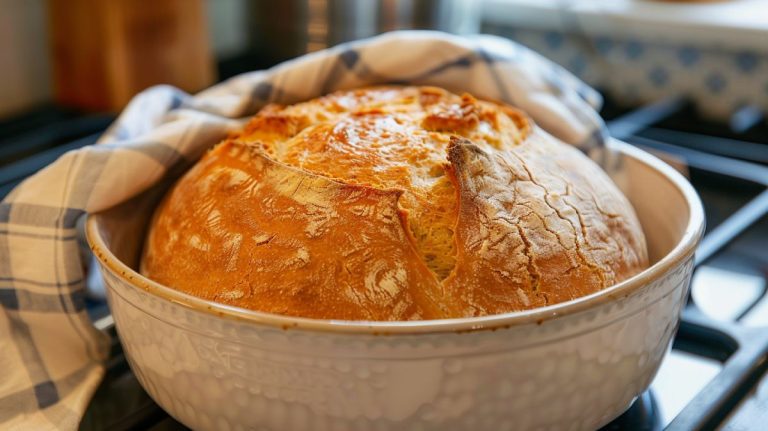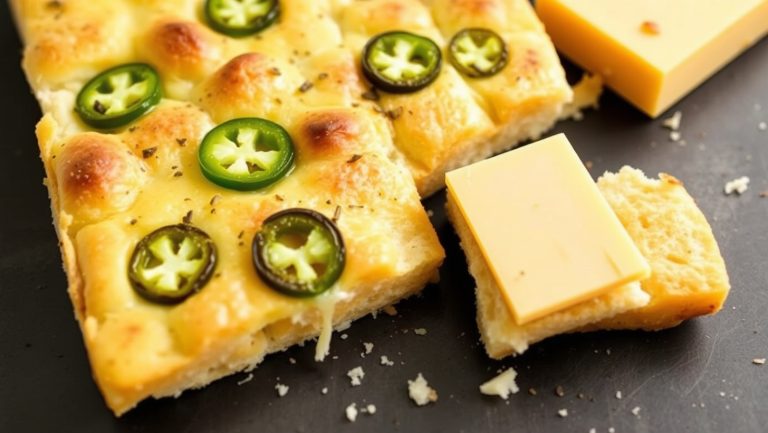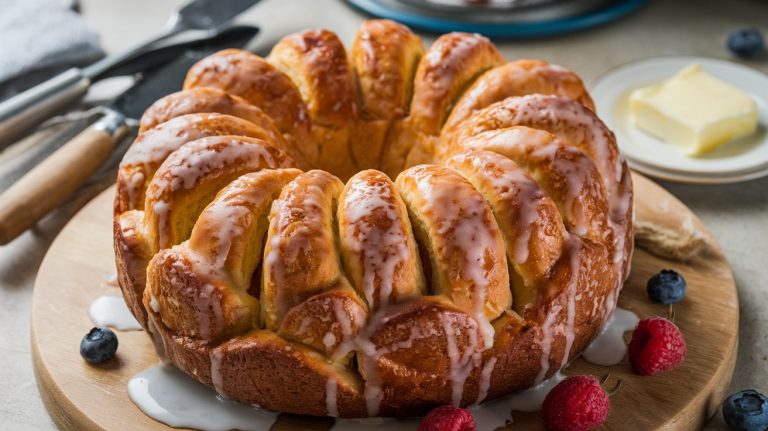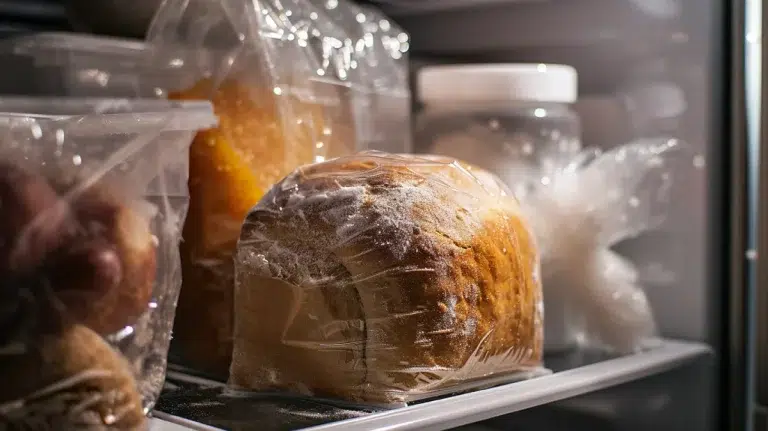Different Types of Sourdough Bread: A World of Flavors
When exploring different types of sourdough bread, you’ll encounter varieties like white-flour sourdough with its soft loaf and subtle tang, and whole-wheat sourdough offering a denser texture and rich flavor. You can also try spelt, rye, or even einkorn sourdough for unique tastes.
Flavored options, such as jalapeños and cheddar or cranberries with orange zest, add a delightful twist. Each variation has its own charm, promising an exciting journey ahead as you learn more about this beloved bread.
Key Takeaways
- White flour sourdough offers a soft loaf with a subtle tang and airy pockets, making it a popular choice.
- Whole-wheat sourdough provides a denser texture and complex flavor due to the use of whole grains.
- Rye sourdough delivers an earthy richness, ideal for traditional recipes and hearty meals.
- Spelt sourdough utilizes low-gluten spelt flour, resulting in a unique flavor and structure when combined with stronger flour.
- Flavored sourdough options, like cinnamon chipotle or feta and sundried tomatoes, introduce creative and diverse taste profiles.
Types of Sourdough Breads by Ingredients
When you immerse yourself in the world of sourdough bread, you’ll discover a delightful variety shaped by the ingredients used.
Start with white-flour sourdough, where refined flour creates a soft loaf with a subtle tang and airy pockets.
Whole-wheat sourdough offers a denser bite and a complex flavor profile thanks to the use of whole grains. Whole wheat sourdough results in denser bread with less gluten and a complex flavor.
If you’re feeling adventurous, try spelt sourdough, which combines low-gluten spelt flour with stronger flour for structure.
Rye sourdough brings an earthy richness, perfect for traditional recipes.
Finally, einkorn sourdough stands out with its nutty flavor and digestibility, making it a unique choice.
Flavored Sourdough Breads
When you think about flavored sourdough breads, the options can tantalize your taste buds with both sweet and savory delights. Imagine biting into a loaf infused with zesty lemon and creamy white chocolate or one packed with spicy jalapeños and sharp cheddar.
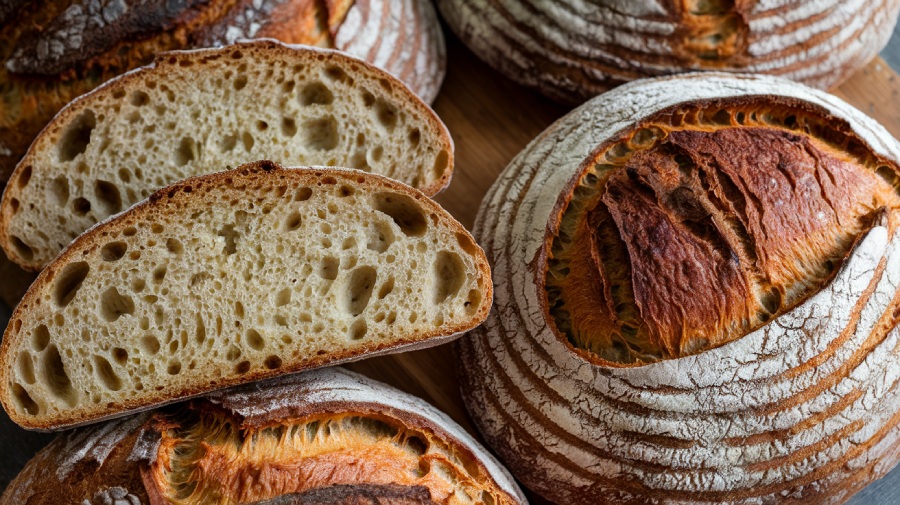
Consider the moisture content of additions to maintain the perfect dough consistency, ensuring your flavors shine through. Additionally, using almond flour in your dough can enhance flavor and moisture retention, creating a unique twist on traditional recipes. With endless unique flavor combinations, there’s plenty of room for your creativity to shine in the kitchen!
Sweet and Spicy Options
If you crave a unique twist on traditional sourdough, sweet and spicy options offer an exciting fusion of flavors that tantalize your taste buds.
Imagine biting into a Cinnamon Chipotle Sourdough, where sweet cinnamon dances with smoky chipotle, creating a delightful contrast. This recipe can be enhanced by using an active sourdough starter to achieve the best flavor and texture, as a healthy starter ensures effective fermentation and rise.
Or try Jalapeño Cinnamon Sourdough, which combines heat with sweetness for a breakfast treat that wakes you up.
For a savory-sweet experience, Garlic and Honey Sourdough balances pungent garlic with the rich sweetness of honey.
Chili and Fig Sourdough offers a unique blend of spicy and fruity, while Cayenne and Maple Sourdough pairs fiery cayenne with the comforting sweetness of maple syrup.
Unique Flavor Combinations
Sourdough bread isn’t just about the tangy flavor; it’s a canvas for unique and exciting flavor combinations that elevate your bread-baking experience.
Imagine biting into a loaf infused with spicy jalapeños and rich cheddar cheese, or savoring the deep, herbal notes of roasted garlic and rosemary.
You can even try a delightful mix of feta and sundried tomatoes for a Mediterranean twist. Active sourdough starter plays a crucial role in developing the flavor profile of these breads.
For something sweet, consider a touch of cranberries and orange zest, adding a bright, tart flavor.
Want a savory option? Blend roasted potatoes, garlic, and rosemary for depth. Sourdough breads have been baked for thousands of years, showcasing the diverse flavors that can be achieved with this unique fermentation process.
With countless combinations, each loaf becomes a new adventure, inviting you to explore flavors that tantalize your taste buds and enhance every meal.
Sourdough Breads by Texture
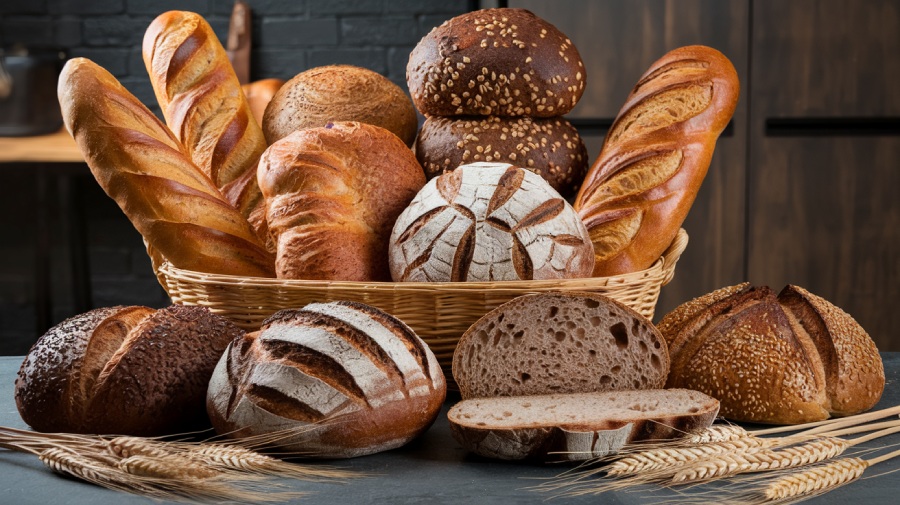
Although the texture of sourdough bread can vary widely, each type offers a unique experience that reflects its ingredients and baking techniques.
You’ll find chewy sourdough that delights with its long fermentation, while the crust can be crispy or slightly chewy, depending on how it’s baked. An open crumb structure, with large, irregular holes, creates an airy sensation in your mouth. The fermentation process, which typically lasts 8-12 hours, allows for the development of distinctive flavors and textures. The use of high-hydration dough enhances the texture, contributing to the moist and satisfying interior of the bread.
Whole grain sourdoughs tend to be denser and nuttier, while white flour varieties present a lighter, more delicate texture. Factors like hydration levels and flour types greatly impact the final product too.
Whole grain sourdoughs offer density and nuttiness, while white flour varieties deliver a light, delicate texture, influenced by hydration and flour type.
Sourdough Breads by Cultural Influence
Across the globe, sourdough bread takes on many forms, each reflecting the rich cultural tapestry of its origin.
In Asia, you’ll find Chinese Mantou, a steamed bread with rice-based starters, and Japanese sourdough that experiments with rice flour for unique textures. The practice of using unique starters enhances the flavors and textures of these breads, showcasing the diversity of sourdough traditions. Additionally, the use of high-protein bread flour in these recipes can significantly improve the dough’s elasticity and structure.
South Korea’s Nurungji-sikppang features crispy bread made from scorched rice.
Meanwhile, Indian sourdough naans and rotis blend traditional flavors with sourdough techniques.
In Europe, Italy boasts the festive Panettone, while Germany’s rye bread offers a dense texture.
The iconic San Francisco sourdough stands out with its tangy flavor.
Middle Eastern breads like Lebanese Khobz Arabi and Ethiopian Injera showcase regional ingredients, offering a taste of their cultural roots and history.
Sourdough Breads by Preparation Method
When it comes to baking, the method you choose can greatly influence the characteristics of your sourdough bread. Each technique offers unique benefits, shaping the flavor and texture of your loaf. Here’s a quick comparison of different preparation methods:
| Preparation Method | Key Feature | Benefits |
|---|---|---|
| No-Knead | Autolyse Process | Crispy crust, minimal work |
| Stretch and Fold | Scheduled Intervals | Airy crumb, increased rise |
| Cold Proofing | Extended Proofing | Complex flavor, easy handling |
| High-Temperature Baking | Initial High Heat | Crisp crust, rapid browning |
| Multi-Day Fermentation | Extended Bulk Fermentation | Complex flavor, better digestibility |
Experimenting with these methods can lead to delightful variations in your sourdough journey! To achieve the best results, it’s important to pay attention to the sourdough starter essentials, as they play a crucial role in fermentation and flavor development. Using Greek yogurt can also be a fantastic way to enhance the texture and nutritional value of your bread.
Specialty Sourdough Breads
Specialty sourdough breads offer a delightful twist on traditional recipes, showcasing unique flavor combinations like cranberry walnut orange or jalapeno cheddar chive. Adding inclusions can enhance the flavor profile even further, allowing bakers to experiment with various ingredients. Incorporating discarded sourdough starter into these specialty breads can add depth to the flavor and improve the texture.
You can elevate your meals with creative serving ideas, from toasting slices for breakfast to pairing them with savory dips.
Unique Flavor Combinations
While exploring the world of sourdough, you’ll discover an array of unique flavor combinations that elevate this beloved bread to new heights.
Imagine biting into a jalapeño and cheddar loaf, where spicy heat meets savory richness. This delightful bread can be crafted using a sticky dough consistency, ensuring a tender crumb and crispy crust.
Or savor the fragrant blend of roasted garlic and rosemary, perfect for pairing with soups. Herbs and spices can enhance aroma and taste, making this combination even more delightful.
For a Mediterranean twist, indulge in feta and sundried tomato, a delightful balance of salty and tangy.
If you’re in the mood for something sweet, try blueberry lemon zest, where fruity freshness dances with a zesty kick.
Experimentation calls with unique blends like coffee and dates or pumpkin and honey, both promising to captivate your taste buds.
Creative Serving Ideas
Sourdough’s versatility extends beyond its unique flavor combinations, inviting you to explore creative serving ideas that can elevate any meal.
For breakfast, try a hearty sandwich filled with scrambled eggs and crispy bacon, or enjoy avocado toast topped with a fried egg for brunch. Adding jalapeño cheddar to your breakfast sandwich can give it an extra kick. You can also use sourdough discard in your breakfast recipes for added texture and flavor.
At lunch, a classic BLT on sourdough offers a satisfying crunch.
For dinner, pair it with a rich French onion soup or use it as a base for pizza bread.
And for dessert—transform stale sourdough into a delicious bread pudding or French toast casserole.
Health Benefits of Sourdough Bread
When you indulge in a slice of sourdough bread, you’re not just savoring its unique flavor; you’re also reaping a host of health benefits.
This delightful bread supports your gut health with its prebiotics and fiber, nurturing beneficial bacteria. Thanks to the fermentation process, sourdough is easier to digest, making it a great option if you’re sensitive to gluten. Additionally, the fermentation process enhances its probiotic properties, further promoting a healthy gut microbiome. The whole grain sourdough varieties are particularly beneficial due to their higher fiber content, which aids in blood sugar regulation.
You’ll also appreciate its lower glycemic index, which helps manage blood sugar levels. With enhanced mineral absorption and a rich antioxidant profile, sourdough can play a part in preventing chronic diseases.
Plus, its nutritious whole grain varieties offer added fiber, promoting digestive wellness.
Tips for Baking Sourdough Bread
Baking sourdough bread is an art that combines science and creativity, allowing you to create a delicious, homemade loaf. To start, choose high-protein bread flour for ideal gluten development, and verify your sourdough starter is active and bubbly. The quality of ingredients directly impacts the taste of the bread, so ensure you’re using fresh and appropriate flours.
Pay attention to water quantity, as it impacts dough texture. Incorporate salt either at the beginning or after the autolyse phase for better control over gluten. During the bulk rise, monitor the dough rather than sticking to a strict timeline. Shape your dough gently, maintaining its integrity, and let it rise in a cloth-lined basket. Preheat your oven, use a Dutch oven for baking, and don’t forget to score the dough for even expansion. Finally, cool the loaf on a wire rack.
Pairing Sourdough Bread With Food
Pairing sourdough bread with food can elevate your dining experience, as its unique tang and hearty texture complement a wide array of dishes.
Whether you’re enjoying a warm bowl of soup or crafting the perfect sandwich, sourdough enhances flavors and textures delightfully.
- Enjoy sourdough with creamy Chicken Florentine Soup for a comforting meal.
- Pair it with a tangy Tomato Feta Soup—pure bliss!
- Elevate your grilled cheese by using sourdough for that satisfying crunch.
- Toss in sourdough croutons for added texture in a Chopped Salami Salad.
- Don’t forget to dip it into Roasted Red Pepper Hummus for a smoky treat.
Frequently Asked Questions
How Can I Store Sourdough Bread for Freshness?
Ah, the noble quest for bread freshness!
To store your sourdough like a pro, opt for breathable cotton or linen bags; they keep moisture in while letting air flow. For short bursts, brown paper bags do the trick, but don’t get too cozy with plastic!
If it’s crusty, avoid airtight containers—your bread deserves better!
And remember, freezing it can extend its life, just don’t forget to thaw and revive it with a little heat.
What Is the Difference Between Sourdough and Regular Bread?
The difference between sourdough and regular bread lies primarily in their leavening processes.
Sourdough uses a natural starter with wild yeast and bacteria, giving it a tangy flavor and chewy texture. In contrast, regular bread relies on commercial yeast for a quicker rise and milder taste.
Sourdough’s longer fermentation enhances nutrient availability and digestibility, while its acidity naturally preserves freshness, allowing it to last longer at room temperature compared to conventional bread.
How Long Does Sourdough Bread Last?
Ever wondered how long your delicious sourdough will stay fresh?
Typically, it lasts about 3 to 5 days at room temperature when stored properly. The first 24 hours are when it’s at its best—crusty on the outside and soft inside.
To keep that freshness, store it in an airtight container. Remember, refrigerating it can dry it out, so stick to room temperature storage for the best results!
Can I Freeze Sourdough Bread?
Yes, you can freeze sourdough bread! Just make sure it’s completely cooled to avoid condensation and freezer burn.
Wrap it tightly in plastic wrap or aluminum foil, then place it in a freezer bag. This way, it’ll stay fresh for up to three months.
When you’re ready to enjoy it, simply thaw it at room temperature or pop it in the toaster for a quick treat!
It’s a great way to preserve your delicious bread.
What Tools Do I Need for Baking Sourdough?
Baking sourdough is like crafting a masterpiece; your tools are the paintbrushes that bring your vision to life.
You’ll need a digital scale for precise measurements, a glass jar for nurturing your starter, and a bench scraper for handling the dough.
A banneton basket shapes your creation, while a Dutch oven gives it that coveted crispy crust.
With these essentials, you’re ready to commence your sourdough journey, turning simple ingredients into art.
Savor the Diversity of Sourdough
In the world of sourdough, there’s so much to explore, from unique flavors to diverse textures. Did you know that nearly 40% of homebakers have embraced sourdough during the pandemic?
This rise in popularity shows just how much people appreciate its tangy taste and health benefits. So, whether you’re trying a classic country loaf or a spiced version, each bite tells a story. Get baking, and let your taste buds commence on this delicious journey.

